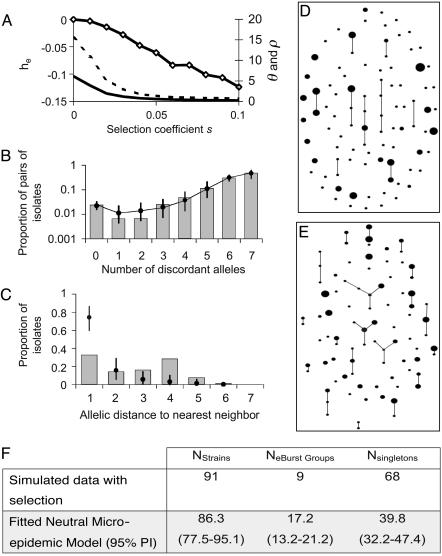Fig. 4.
Analysis of a model with hitch-hiking selection. Selection acts upon a single unobserved locus that entirely determines the fitness of a strain. Variation occurs at the same population diversification rates, θ and ρ, as the MLST-defining loci. Mutation causes the fitness of an allele to be multiplied by a log-normal random deviate of mean 1 and standard deviation s, the selection coefficient. We also tested a normal random deviate, and truncated distributions including only beneficial or harmful mutations. Results were similar in each case. (A) The allelic mismatch distribution obtained for the neutral microepidemic model is refitted to simulated populations with no clustering, produced with θ = 5.7, ρ = 17.1, and varying values of the selection coefficient. The fit remains good, but selection results in reduced estimates of θ (solid line) and ρ (dashed line) and negative values of he (diamonds). (B–F) A single sample is drawn from a simulated population with both selection and clustering, with θ = ρ = 64, N = 2,000, and s = 0.1. The sample of size n = 250 includes nc = 25 epidemic clusters of mean size  , and we attempt to refit the neutral microepidemic model to this sample produced with selection. (B) The allelic mismatch distribution fits acceptably, resulting in estimates θ = 6.4, ρ = 9.6, and he = 0.015. However, the resulting nearest neighbor distribution (C) and the eburst analyses (D, sample simulated with selection and clustering; E, sample from best-fit neutral microepidemic model; F, summary statistics) fit poorly.
, and we attempt to refit the neutral microepidemic model to this sample produced with selection. (B) The allelic mismatch distribution fits acceptably, resulting in estimates θ = 6.4, ρ = 9.6, and he = 0.015. However, the resulting nearest neighbor distribution (C) and the eburst analyses (D, sample simulated with selection and clustering; E, sample from best-fit neutral microepidemic model; F, summary statistics) fit poorly.

